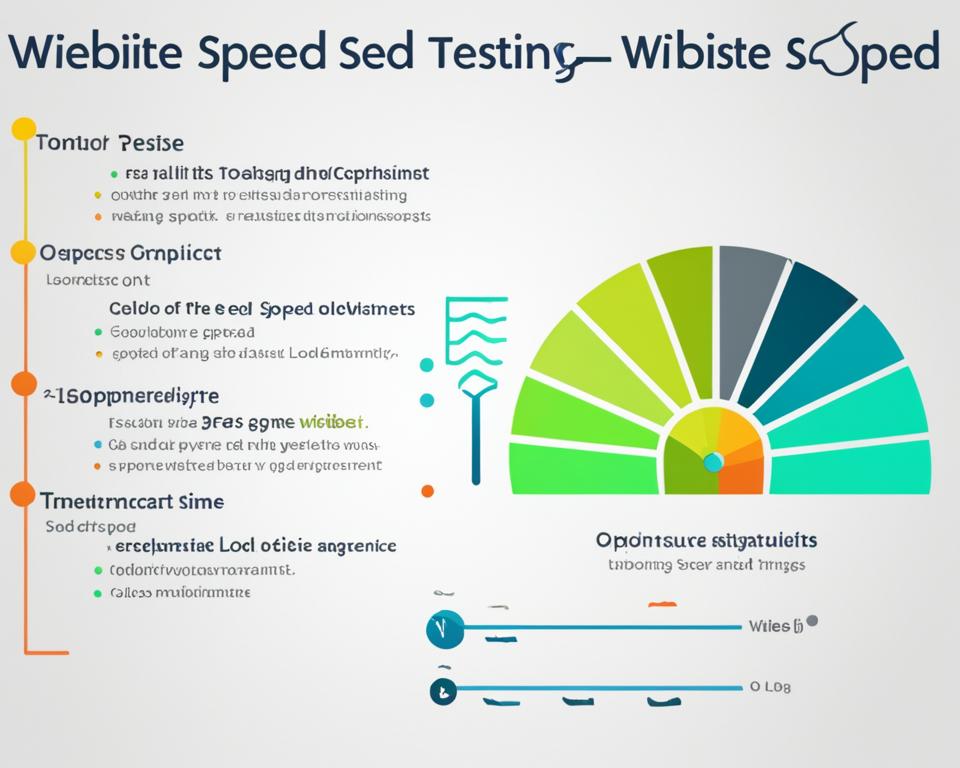Are slow loading times on your website costing you valuable traffic and potential customers? You may be surprised to learn just how much website speed can impact your online success. Did you know that a one-second delay in page load time can result in a 7% reduction in conversions?
When your website takes too long to load, visitors are likely to abandon it and look for alternatives. Not only does this lead to a loss in potential revenue, but it also negatively affects your website’s visibility in search results. In fact, Google considers website speed as one of the ranking factors, meaning that a slow-loading website may not rank as high in search engine results.
If you’re ready to boost your website’s loading time and optimize its performance, you’ve come to the right place. In this article, we’ll provide you with valuable recommendations and strategies to improve your website’s speed, attract more visitors, and increase conversions. Let’s dive in!
Key Takeaways:
- A one-second delay in page load time can lead to a 7% reduction in conversions.
- Website speed affects both revenue and visibility in search results.
- Optimizing website speed is crucial for attracting visitors and increasing conversions.
Understanding Website Speed Optimization
Website speed optimization involves implementing techniques to make your site load as quickly as possible. By optimizing your website’s speed, you can ensure that users have a positive browsing experience and minimize the risk of losing potential customers. Key performance metrics for measuring website speed include:
- Time to First Byte (TTFB): The time taken for the browser to receive the first byte of data from the server.
- First Contentful Paint (FCP): The time it takes for the first piece of content to be displayed on the page.
- Largest Contentful Paint (LCP): The time it takes for the largest piece of content to be displayed on the page.
- Page Load Time: The complete time it takes for the page to load.
These metrics play a critical role in determining how quickly users can access and view the content on your website. It is essential to keep these metrics within recommended ranges to ensure a good user experience. According to industry standards, the average page load time for top websites is 2.5 seconds on desktop and 8.6 seconds on mobile devices.

Website speed optimization is imperative for enhancing user satisfaction, reducing bounce rates, and improving conversion rates. To achieve optimal website speed, you must consider various factors, including server response time, file sizes, browser caching, and resource optimization. Let’s explore some strategies and techniques to improve your website’s speed and overall performance.
The Impact of Website Speed on Conversion, Visibility, and Usability
Website speed plays a crucial role in determining the success of your online presence. It directly influences important factors such as website conversion, visibility in search results, and overall usability, which ultimately impacts your customer satisfaction. Research has shown that faster page load times lead to higher conversion rates, with load times between 0 and 4 seconds showing the best rates.
A fast-loading website not only enhances the user experience but also improves your search engine rankings, making your website more visible to potential customers. When your website loads slowly, it can result in a poor user experience, leading to increased bounce rates and lower rankings in search engine results.
Customer satisfaction is closely tied to website speed and performance. Users expect websites to load quickly and smoothly, and when they don’t, it can lead to frustration and a negative perception of your brand. Slow website speed can significantly impact customer satisfaction and hinder repeat visits and conversions.
Improving your website speed is crucial for boosting website conversion, increasing your visibility in search results, and enhancing overall website usability. By optimizing your website’s performance and reducing page load times, you can provide a seamless browsing experience and increase the likelihood of user engagement and conversion.
“A fast website not only enhances usability but also improves search engine rankings, making your website more visible to potential customers.”
To illustrate the impact of website speed, we can take a look at the following data:
| Statistic | Faster Page Load Times | Slower Page Load Times |
|---|---|---|
| Conversion Rates | Higher rates, especially with load times between 0 and 4 seconds | Lower rates |
| Visibility in Search Results | Improved rankings | Lower rankings |
| Customer Satisfaction | Enhanced user experience, higher satisfaction | Poor user experience, lower satisfaction |

As you can see, the difference in website speed significantly affects key metrics such as conversion rates, visibility in search results, and customer satisfaction. By prioritizing website speed optimization, you can create a positive user experience, increase your online visibility, and ultimately drive better business outcomes.
The Importance of Scalability in Website Speed Optimization
As your business grows and attracts more visitors to your website, it is crucial to prioritize scalability in your website speed optimization strategy. Scalability refers to the ability of your website to handle increased traffic without compromising its speed. By focusing on optimizing your website’s speed, you can ensure that it remains responsive and efficient even as your user base expands.
Handling increased traffic is a key aspect of website scalability. When your website experiences a surge in visitors, it should be able to accommodate the higher demand without slowing down or causing delays. A scalable website can effortlessly manage the influx of traffic, delivering a seamless user experience.
Maintaining speed is another critical factor in scalability. As your website attracts more users, it is essential to sustain fast load times to keep visitors engaged and prevent them from abandoning your site due to poor performance. Websites that load quickly not only enhance user satisfaction but also improve your chances of converting leads into customers.
Optimizing your website’s speed is paramount for scalability. By implementing effective strategies and techniques, such as leveraging caching, using a Content Delivery Network (CDN), and optimizing images and code, you can enhance your website’s performance and ensure it remains fast and responsive as your business continues to grow.
Tools for Testing and Analyzing Website Speed
Before optimizing your website speed, it is important to test and analyze your current loading times. By understanding how your website performs, you can identify areas for improvement and make informed optimizations. Several tools are available to assist you in this process, providing detailed reports and recommendations. Here are a few recommended tools for website speed testing:
1. Google PageSpeed Insights
Google PageSpeed Insights is a free tool developed by Google that analyzes the performance of your web pages and provides suggestions for improving speed. It evaluates both mobile and desktop versions of your site, giving you insights into critical performance metrics.
2. Pingdom
Pingdom is another popular website speed testing tool that provides comprehensive reports on your website’s performance. It measures various factors such as page load time, file sizes, and performance grades. Additionally, Pingdom offers recommendations for optimizing your website speed.
3. YSlow
YSlow, developed by Yahoo, is a browser extension that assesses your website’s speed based on Yahoo’s performance guidelines. It offers detailed performance scores and provides recommendations for optimizing elements such as CSS, JavaScript, and images.
4. GTmetrix
GTmetrix is a powerful tool that provides in-depth insights into your website’s speed and performance. It combines the analysis from both PageSpeed Insights and YSlow, offering recommendations for improving various aspects of your site’s performance.
By using these tools for website speed testing, you can gather valuable data and recommendations to optimize your website’s performance. It is recommended to test your website speed both before and after making any optimizations to track your progress and ensure the effectiveness of your changes.
Next, we will explore effective strategies for improving website performance and boosting speed. Stay tuned!

Effective Strategies for Improving Website Performance
When it comes to improving your website’s performance and speed, there are several effective strategies you can implement. By optimizing various aspects of your website, you can enhance user experience, increase engagement, and boost your overall online presence. Let’s explore some of the key strategies:
1. Utilize a Content Delivery Network (CDN)
A Content Delivery Network (CDN) is a network of servers distributed across different geographical locations. By storing copies of your website’s static content on these servers, a CDN enables faster content delivery and reduces latency. This results in improved website speed and performance, especially for users located far away from your hosting server.
2. Choose a Performance-Optimized Website Hosting Solution
Your choice of website hosting provider plays a crucial role in determining your website’s speed and performance. Opting for a performance-optimized hosting solution with robust server infrastructure, advanced caching mechanisms, and efficient resource management can significantly enhance your website’s speed and response time.
3. Optimize Image Size and Format
Images are an integral part of any website, but large and uncompressed images can significantly slow down page load times. To optimize image delivery, ensure that you resize and compress your images without compromising quality. Additionally, consider using modern image formats such as WebP, which provide better compression without sacrificing visual quality.
4. Reduce the Number of Plugins
While plugins offer additional functionality and features, an excessive number of plugins can negatively impact website performance. Each plugin adds extra code and includes additional server requests, potentially slowing down your website. Regularly review and remove unnecessary plugins to minimize their impact on performance.
5. Minimize JavaScript and CSS Files
Reducing the number and size of JavaScript and CSS files on your website can have a significant impact on performance. Optimize and combine these files where possible to minimize the number of server requests required to load your web pages. This improves load times and enhances overall website performance.
6. Implement Website Caching
Website caching involves storing static versions of your web pages in the user’s browser or on the server. This eliminates the need to retrieve data from scratch every time a user visits your site, resulting in faster page load times. Implementing browser caching and server-side caching mechanisms can substantially enhance website performance.
By employing these effective strategies, you can improve your website’s performance, enhance user experience, and boost your online visibility. Remember, every optimization counts when it comes to website speed and performance, so regularly monitor and maintain your site to stay ahead of the competition.
| Strategy | Key Benefits |
|---|---|
| Utilize a Content Delivery Network (CDN) | Faster content delivery, reduced latency, improved user experience |
| Choose a Performance-Optimized Website Hosting Solution | Enhanced server infrastructure, advanced caching mechanisms, improved response times |
| Optimize Image Size and Format | Faster page load times, improved visual experience, reduced bandwidth usage |
| Reduce the Number of Plugins | Decreased server requests, improved load times, streamlined website code |
| Minimize JavaScript and CSS Files | Reduced server requests, faster rendering, enhanced performance |
| Implement Website Caching | Faster page load times, improved user experience, reduced server load |
Importance of Performance Budget and Optimization
Implementing a performance budget is an important step in optimizing your website’s speed. A performance budget helps you determine what type of content and features you can include on your site while still maintaining optimal performance. By setting performance goals and regularly monitoring your website’s speed, you can ensure that your website is delivering the best possible user experience.
Why a Performance Budget?
A performance budget is a strategic approach to manage and prioritize the resources allocated to your website’s performance. It sets limits on the size and complexity of your website, ensuring that it remains fast and efficient. By establishing a budget, you can make informed decisions about the content and functionality you include on your site, optimizing it for better speed and usability.
A well-defined performance budget also helps you focus on the most critical areas of your website that require optimization. It allows you to identify potential bottlenecks and prioritize efforts to eliminate them, ensuring that your site consistently delivers a seamless user experience.
Setting Performance Goals
When creating a performance budget, it’s essential to set specific performance goals for your website. These goals should align with industry benchmarks and user expectations. Key metrics to consider include page load time, time to interactive, and other performance indicators that directly impact user experience.
For example, your performance budget may include targets such as:
- Page load time should not exceed 2 seconds.
- Time to interactive should be under 3 seconds.
- Images should be optimized to load within 200 milliseconds.
By setting these goals, you establish clear targets for your website’s performance and provide a framework for ongoing optimization efforts.
Monitoring Website Performance
Regularly monitoring your website’s speed and performance is crucial to ensure that it aligns with your performance budget. By using performance testing tools, such as Google PageSpeed Insights or GTmetrix, you can assess your website’s current performance, identify areas for improvement, and track progress over time.
These tools provide detailed reports on various performance metrics, including recommendations for optimizing your website. By monitoring your website’s performance regularly, you can identify any performance issues, make necessary adjustments, and ensure your website remains aligned with your performance goals.
Optimizing Web Content
To stay within your performance budget, it’s essential to optimize your web content. Here are some strategies to consider:
- Compress and optimize images to reduce file sizes without compromising quality.
- Minify HTML, CSS, and JavaScript files to reduce their size and improve load times.
- Leverage browser caching to store static resources on users’ devices, reducing server requests.
- Load resources asynchronously to prevent blocking and improve overall performance.
- Prioritize critical above-the-fold content to ensure faster rendering and a better user experience.
By implementing these optimization techniques, you can deliver a fast and efficient website that meets your performance goals and provides an excellent user experience.
Remember, optimizing your website’s performance is an ongoing process. Regularly assess and update your performance budget, monitor your website’s speed, and optimize your content to ensure that your website remains fast, user-friendly, and competitive.
Using Asynchronous Loading for Improved Performance
To further enhance the speed and overall performance of your website, consider implementing asynchronous loading. This technique allows certain elements on your web page, such as scripts and media files, to load independently of each other, rather than waiting for one element to load before the next begins.
Asynchronous loading is particularly effective in improving page loading speed as it reduces the blocking time caused by sequential loading. By allowing different elements to load simultaneously, your website can provide a smoother and faster user experience.
Benefits of Asynchronous Loading
- Improved page loading speed
- Enhanced user experience
- Reduced bounce rates
- Increased engagement and conversions
Implementing asynchronous loading can make a significant difference in your website’s performance. By reducing the waiting time for various elements to load, users can start interacting with your website more quickly, resulting in better engagement and higher conversion rates.
Asynchronous loading allows your website to deliver an optimized experience where users don’t have to wait for all elements to load before exploring your content.
To implement asynchronous loading, you can utilize techniques such as deferred JavaScript loading or load scripts asynchronously. By strategically implementing these techniques, you can improve your website’s loading speed and ensure a seamless browsing experience for your visitors.
Summary
Using asynchronous loading is a powerful approach to improve your website’s performance. By allowing elements to load independently, you can significantly enhance page loading speed and provide a better user experience. Consider implementing asynchronous loading as part of your overall optimization strategy to further boost your website’s speed and performance.
| Benefits of Asynchronous Loading | Techniques for Implementation |
|---|---|
| Improved page loading speed | Deferred JavaScript loading |
| Enhanced user experience | Load scripts asynchronously |
| Reduced bounce rates | |
| Increased engagement and conversions |
Leveraging Browser Caching for Faster Page Load Times
When it comes to reducing page load time and improving the overall performance of your website, browser caching is a powerful technique to consider. By leveraging browser caching, you can provide a faster and more efficient user experience for your visitors.
So, what exactly is browser caching? It’s a process that allows certain elements of your web page to be stored in a user’s browser, so they don’t have to be reloaded every time the user visits your site. These elements can include images, CSS files, JavaScript files, and other static resources that are used by your website.
By utilizing browser caching, you can take advantage of the fact that many resources on a web page don’t change frequently. By instructing the user’s browser to store these resources locally, subsequent visits to your website result in faster loading times since the browser doesn’t need to retrieve those resources from the server again. Instead, it can fetch them from the local cache, significantly reducing the time it takes to load your web page.
Implementing browser caching involves setting appropriate caching headers or using cache-control directives in your server configuration. By doing so, you can specify how long the browser should store specific resources before checking if they need to be refreshed from the server. This not only reduces the load on your server but also improves the user experience by delivering content faster.
Here’s an example of how you can set caching headers using the HTTP headers in an Apache server configuration:
<IfModule mod_expires.c>
ExpiresActive On
ExpiresByType text/css "access plus 1 month"
ExpiresByType image/jpeg "access plus 1 year"
ExpiresByType image/png "access plus 1 year"
ExpiresByType application/javascript "access plus 1 month"
</IfModule>
By specifying appropriate expiration dates for different resource types, you can control how long the browser caches these resources. This way, returning visitors will experience faster load times as their browsers can retrieve the static resources directly from the cache.
Implementing browser caching is an effective strategy to reduce page load time and enhance the performance of your website. By taking advantage of the caching capabilities of modern browsers, you can improve the overall user experience and keep your visitors engaged.
Conclusion
In conclusion, optimizing your website speed is crucial for improving website performance, attracting more visitors, and increasing conversion rates. By implementing the strategies and techniques mentioned in this article, such as using a Content Delivery Network (CDN), optimizing images, reducing plugins, and leveraging caching, you can significantly enhance your website’s speed and provide a better user experience.
Regularly testing and analyzing your website’s speed, and making necessary optimizations, will help you stay ahead of the competition and maximize your online success. Remember that website speed optimization is an ongoing process, and it is important to continuously monitor and improve your website’s performance to ensure optimal results. By focusing on improving website speed, you can create a website that loads quickly, engages users, and drives positive business outcomes.
Take the necessary steps to boost your website speed today, and start reaping the benefits of improved performance and user satisfaction. Your website’s speed plays a vital role in attracting and retaining visitors, improving your search engine rankings, and ultimately driving the success of your online presence. Don’t overlook the importance of website speed optimization – invest the time and effort now for a faster, more efficient website that delivers exceptional user experiences.







